
The Philippines' Taal Volcano belched into life on Sunday, spewing a cloud of ash half a kilometer into the sky and shutting down Manila's international airport less than 80km (50 miles) away. As lava shot out of the volcano and earthquakes rumbled nearby, scientists warned of an "imminent" eruption.
The Taal Volcano last erupted in 1977, but a previous eruption in 1911 killed more than 1,300 people. Residents of the area surrounding Taal Lake are therefore worried about the possibility of another disaster.
Such catastrophic eruptions will only become more common in the coming 100-200 years, Lloyd's of London warned on Tuesday. According to the venerable insurer, around half of the world's volcanoes in eruption are expected to have "reawakened" during this time, after lying dormant for generations.
Moreover, Lloyd's added, "about one percent of the world's population lives in 15 cities within range of an active volcano."
These cities include Naples in Italy, whose 900,000 residents live in the shadow of Mount Vesuvius. Famed for wiping out the Roman city of Pompeii in 79AD, Vesuvius has not erupted since 1944. Geophysics professor Bill McGuire told Lloyds that "another eruption at any time would not be a surprise."
Also on the volcanic chopping block are the Japanese city of Kagoshima, which sits opposite the Sakurajima volcano; Seattle, which lies 100km (60 miles) from Mount Rainier; and the islands of Hawaii, which are constantly threatened by slow-leaking lava flows.
The Lloyd's report warns that "Volcanic unrest is thus a direct threat not only to the urban population, but also to the stable flow of international business."
Businesses and homeowners looking to insure their livelihoods against volcanic damage should read the fine print though. Lloyd's was hit with a federal class action lawsuit last year, in which it was accused of "steering" Hawaiian customers in volcano-threatened areas away from comprehensive policies that would have covered lava damage, and toward policies that left them unable to claim when their homes went up in flames following the Kilauea eruption in 2018. An earlier lawsuit forced Lloyd's to pay the aggrieved homeowners their policy limits plus interest.
Legal wrangling aside, catastrophe insurance is big business. The sector is predicted to grow by 5.49 percent this year, and though natural disasters often spell massive losses for insurers, catastrophe bonds - which allow investors to back insurance risks - have become more popular, and are now a $30-billion-strong market.
Of course, none of this matters if a so-called 'Supervolcano' decides to blow its top. When Mount Tambora - located in modern-day Indonesia - erupted in 1815, roughly 100,000 people were killed in the immediate aftermath. The ash cloud that followed caused three years of climate change that led to crop failure and famines across the world.
Further back, the eruption of the Toba supervolcano - also located in Indonesia - some 74,000 years ago is said to have plunged the earth into a decade-long 'volcanic winter'.



Comment: Volcanoes, Earthquakes And The 3,600 Year Comet Cycle